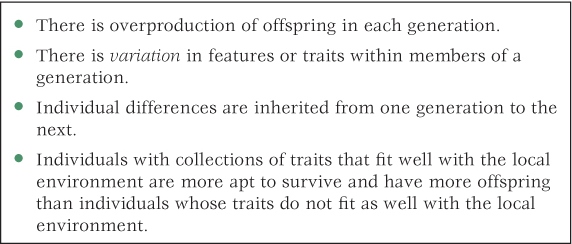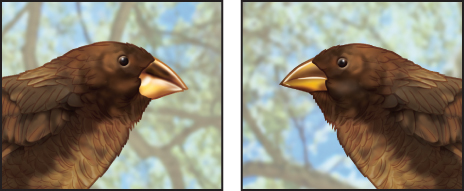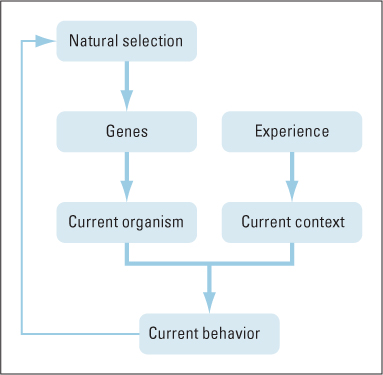3.3 Evolution by Natural Selection
Lady Ashley, a pillar of London society in the 1850s, is purported to have said upon hearing Darwin’s ideas that humans evolved from apes, “Let us hope it’s not true; but if it is true, let us hope that it does not become widely known.” Lady Ashley’s wish did not come true, as Darwin’s theory is widely known today and serves as the foundation for modern biology and is also of central importance for understanding human psychology.
Darwin’s Insight: Selective Breeding Occurs in Nature
17
What insight led Darwin to his theory of evolution? How is natural selection similar to and different from artificial selection?
The idea that plants and animals can be modified by selective breeding was understood long before Darwin was born. In the first chapter of The Origin of Species, Darwin (1859/1963) referred to such human-controlled selective breeding as artificial selection, and he reminded readers of the enormously diverse varieties of plants and animals that had been produced through that procedure. He then pointed out—and this was his true, original insight—that breeding in nature is also selective and can also produce changes in living things over generations.
Selective breeding in nature, which Darwin labeled natural selection, is dictated not by the needs and whims of humans but by the obstacles to reproduction that are imposed by the natural environment. Those obstacles include predators, limited food supplies, extremes of temperature, difficulty in finding and attracting mates for sexual reproduction—anything that can cut life short or otherwise prevent an organism from producing offspring. Animals and plants that have characteristics that help them overcome such obstacles are, by definition, more likely to have offspring than those that lack these characteristics.
71

Darwin’s concept of natural selection is a simple one, having four core concepts (see Table 3.1). First, more individuals are born in a generation than will survive. Second, not all members of a generation are the same—there is variation in features or traits. Third, these individual differences are inherited, passed from one generation to the next. Fourth, individuals with collections of traits that fit well with the local environment are more apt to survive and have more offspring than individuals whose traits do not fit as well with the local environment. Any inherited trait that increases the number of offspring that an individual produces is automatically “selected for,” as the trait is passed on to those offspring. Conversely, any inherited trait that decreases the number of one’s offspring is automatically “selected against,” appearing in fewer members of the next generation. Thus, as long as inheritable differences exist among individuals in an interbreeding population, and as long as some of those differences affect survival and reproduction, evolution will occur.
Core concepts of Darwin’s theory of natural selection

Genetic Diversity Provides the Material for Natural Selection
18
How are genes involved in evolution? What are the sources of genetic diversity on which natural selection acts?
Darwin knew nothing of genes. He realized that something, passed along through eggs and sperm, must provide the hereditary foundation for evolution, but he did not know what. Mendel’s work, which was the first step toward our modern knowledge of genes, was unknown to most scientists until about 1900, long after Darwin’s death. Today we know that genes are the units of heredity and that evolution entails changes, from generation to generation, in the frequencies of particular genes in an interbreeding population. Genes that improve an individual’s ability to survive and reproduce in the existing environment increase from generation to generation, and genes that impede this ability decrease from generation to generation.
The genetic variability on which natural selection acts has two main sources: (1) the reshuffling of genes that occurs in sexual reproduction (already discussed) and (2) mutations. Mutations are errors that occasionally and unpredictably occur during DNA replication, causing the “replica” to be not quite identical to the original. In the long run of evolution, mutation is the ultimate source of all genetic variation. As would be expected of any random change in a complex, organized structure, new mutations are more often harmful than helpful, and natural selection usually weeds them out. But occasionally a mutation is useful, producing a protein that affects the organism’s development in a way that increases its ability to reproduce. Because of its effect on reproduction, the gene arising from such a mutation increases in frequency from generation to generation. At the level of the gene, this is evolution.
72
Prior to the modern understanding of genes, many people believed that changes in an individual that stem from practice or experience could be inherited and therefore provide a basis for evolution. For example, some argued that early giraffes, by frequently stretching their necks to reach leaves in trees, slightly elongated their necks in the course of their lives and that this change was passed on to their offspring, resulting, over many generations, in the long-necked giraffes we see today. That idea, referred to as the inheritance of acquired characteristics, is most often attributed to Jean-Baptiste de Lamarck (1744–1829), although many other evolutionists, both before and after Lamarck, held the same view (Futuyma, 1997). Even Darwin did not reject that idea, but he added to it the concepts of random variation and natural selection.
The biologist August Weismann established the doctrine of the separation of the germ (sex cells) and somatic (body cells) lines. What happens to the body cells during the life of an animal does not affect that animal’s gametes (egg and sperm). No matter how many generations of mice have their tails cut off, tails persist. Today, evolution is defined as changes in gene frequency between populations of individuals, with changes in genes being the “cause” of speciation. However, animals inherit more than just their genes. They inherit chemicals within the egg and some cellular machinery, as well as a species-typical environment (a womb in mammals, for example). Although genes remain the focus of evolutionary change, as we saw in the earlier section on epigenetics, occasionally, experiences within an animal’s lifetime can result in inheritance of features across generations.
Environmental Change Provides the Force for Natural Selection
19
How does change in the environment affect the direction and speed of evolution? How did a study of finches illustrate the role of environmental change in evolution?
Evolution is spurred by changes in the environment. If the environment were completely stable, organisms would adapt as fully as possible and change little or not at all thereafter. But the environment keeps changing. Climates change, sources of food change, predators change, and so on. When the conditions of life change, what was previously a useful characteristic may become harmful, and vice versa.
Darwin viewed evolution as a slow and steady process. But today we know that it can occur rapidly, slowly, or almost not at all, depending on the rate and nature of environmental change and on the degree to which genetic variability already exists in a population (Gould & Eldredge, 1993; Pagel et al., 2006). Environmental change spurs evolution not by causing the appropriate mutations to occur but by promoting natural selection. Some mutations that previously would not have been advantageous and would have gradually been weeded out by natural selection, are advantageous in the new environment, so they are passed along in increasing numbers from generation to generation. Evolution sometimes occurs so quickly that people can see it happen. In fact, scientists since Darwin’s time have reported more than a hundred different examples of observed evolution (Endler, 1986; Weiner, 1994).

Some of the most well-documented examples of observed evolution come from the work of Peter and Rosemary Grant, who for more than 30 years studied a species of finch, the medium ground finch, on one of the Galápagos Islands (Grant & Grant, 2008). The Grants found that the members of this species differ somewhat in the thickness of their beaks, that the variation is inheritable, and that environmental changes can result in rapid evolution toward either thicker or thinner beaks. In the 1970s, a severe drought lasting several years caused most of the finches to die because the plants that produce the seeds they eat failed to grow. The birds that survived and produced offspring were those that happened to have thicker, more powerful beaks—powerful enough to crack open the large, hard-shelled seeds that remained after the smaller seeds had been eaten (see Figure 3.10).
73
Two decades later, another species of ground finch, the large ground finch, established a breeding colony on the island and began competing with the medium ground finch for food. The intruders were much better adapted for eating the large, hard-shelled seeds than were the medium ground finches, but they were less well adapted for eating the small seeds. The result, for the medium ground finches, was depletion in the supply of large seeds but not of small seeds. Under this condition, the medium ground finches with thinner bills, better adapted for eating the small seeds, were more likely to survive and produce offspring than were those with thicker bills. Within a few generations under this new set of conditions, the average beak thickness of the medium ground finches declined considerably (Grant & Grant, 2006).
The evolution of simple or small changes, such as in skin pigmentation or in beak thickness, can occur in a few generations when selection conditions are strong, but more complex changes require much more time. The difference between, say, a chimpanzee brain and a human brain could not have come about in a few generations, as it must have involved many mutations, each of which would have promoted a slight selective advantage to the chimpanzee (in its environment) or to the human (in our environment). When evolutionists talk about “rapid” evolution of complex changes, they are usually talking about periods measured in hundreds of thousands of years (Gould & Eldredge, 1993). Figure 3.11 provides a simplified sketch of how evolution by natural selection works to produce new forms and functions.

Evolution Has No Foresight
20
What are three mistaken beliefs about evolution, all related to the misconception that foresight is involved?
People sometimes mistakenly think of evolution as a mystical force working toward a predetermined end. One manifestation of this belief is the idea that evolution could produce changes for some future purpose, even though they are useless or harmful at the time that the change occurs. But evolution has no foresight. The finches studied by the Grants could not have evolved thicker beaks in anticipation of drought, or thinner ones in anticipation of thick-beaked competitors. Only genetic changes that increase survival and reproduction in the immediate environment can proliferate through natural selection.
Another manifestation of the belief in foresight is the idea that present-day organisms can be ranked according to the distance they have moved along a set evolutionary route toward some planned end (Gee, 2002). For example, some may think of humans as the “most evolved” creatures, with chimpanzees next and amoebas way down on the list. But evolution has no set route or planned end. Humans, chimps, and amoebas have their different forms and behavioral characteristics because of chance events that resulted in them occupying different niches in the environment, where the selection criteria differed. The present-day amoeba is not an early step toward humans but rather a creature that is at least as well adapted to its environment as we are to ours. The amoeba has no more chance of evolving to become like us than we have of evolving to become like it.
74
A third manifestation of the belief in foresight is the idea that natural selection is a moral force, that its operation and its products are in some sense right or good. In everyday talk, people sometimes imply that whatever is natural (including natural selection) is good and that evil stems from society or human contrivances that go beyond nature. This is referred to as the naturalistic fallacy, and it precisely that, a fallacy. Nature is neither good nor bad, moral nor immoral. To say that natural selection led to such and such a characteristic does not lend any moral virtue to that characteristic. Fighting, for example, is as much a product of evolution as is cooperation, but that is no reason to consider them morally equivalent.
SECTION REVIEW
Natural selection is the driving force of evolutionary change.
How Natural Selection Works
- To the degree that a trait enhances survival and reproduction, genes producing that trait are passed on to offspring. The result is that such genes become more frequent over generations.
- Mutations and reshuffling of genes in sexual reproduction provide genetic diversity on which natural selection operates.
Role of Environmental Change
- The rate and nature of environmental change affect the rate and course of evolution. Examples are the effects of drought and of competition from another species on the evolution of beak thickness in finches.
- Complex changes, requiring many mutations, require a long time to evolve.
Evolution Lacks Foresight
- Natural selection can only lead to changes that are immediately adaptive; it cannot anticipate future needs.
- There is no preset pathway for evolution.
- The naturalistic fallacy contends that just because something evolved and is “natural” does not mean that it is “good” or “moral.” Natural selection is not a moral force.